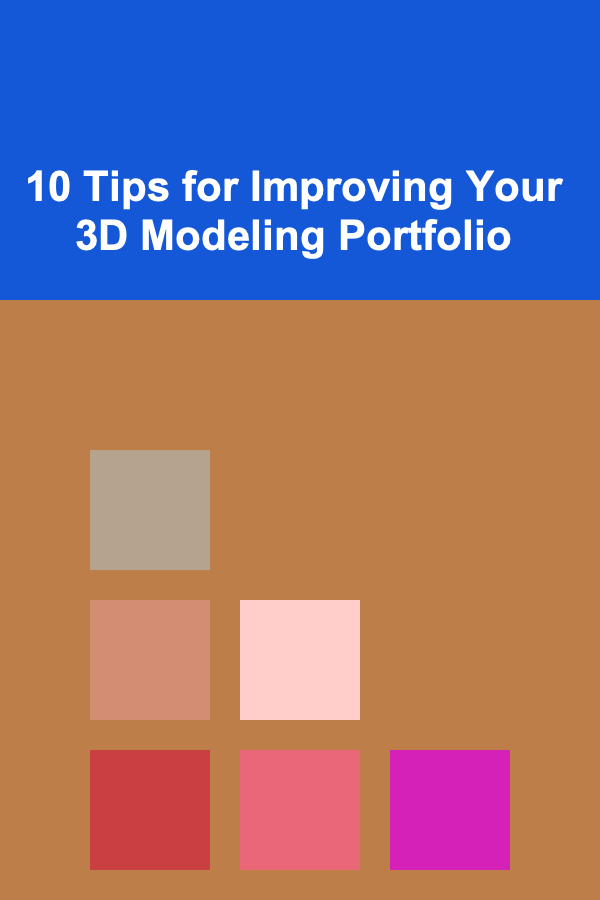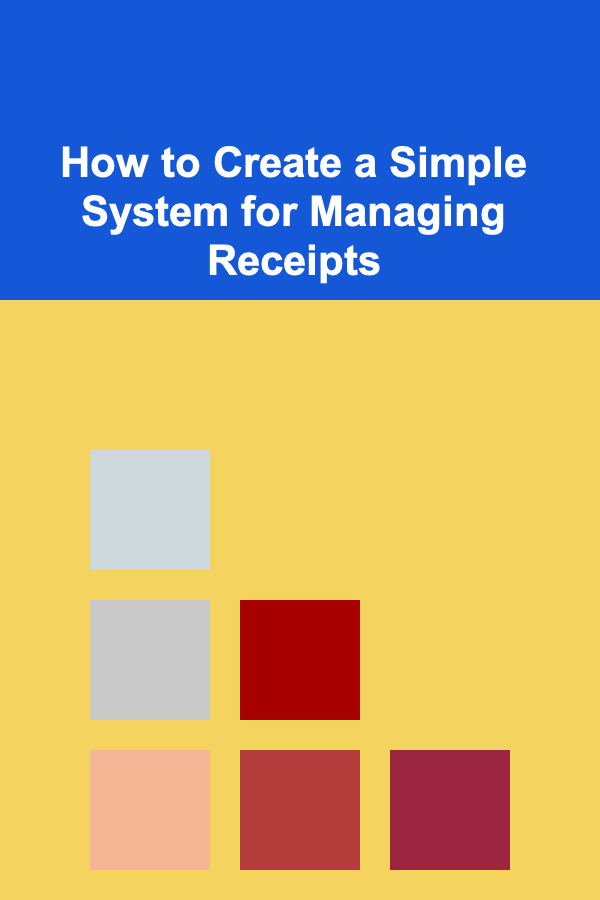
10 Tips for Improving Your 3D Modeling Portfolio
ebook include PDF & Audio bundle (Micro Guide)
$12.99$5.99
Limited Time Offer! Order within the next:

A well-curated 3D modeling portfolio is one of the most important assets for any artist in this field. Whether you're a beginner or an experienced professional, your portfolio serves as a reflection of your skills, creativity, and technical expertise. In this article, we'll explore 10 essential tips to help you improve and showcase your 3D modeling portfolio in the most effective way possible.
Showcase a Variety of Work
One of the key components of a great 3D modeling portfolio is diversity. Showcasing a variety of work demonstrates your versatility as a 3D artist. Potential employers or clients want to see that you're capable of handling different types of projects, from realistic characters to stylized objects or architectural designs.
What to Include:
- Characters: Include both human and animal models. Focus on modeling, rigging, and texturing to demonstrate a well-rounded skill set.
- Environments: Show scenes with complex lighting and realistic textures. Environments allow you to showcase your knowledge of composition and lighting.
- Hard Surface Models: From cars to machines, showing your ability to model mechanical objects with precision is a crucial skill.
- Props and Assets: Include smaller objects like furniture, gadgets, and other props to demonstrate your attention to detail and ability to create lifelike models.
By diversifying your work, you ensure that your portfolio appeals to a wide range of potential clients and employers.
Prioritize High-Quality Renders
The visual quality of your renders plays a huge role in how your work is perceived. A high-quality render can elevate even the simplest model, making it look polished and professional. When it comes to portfolio presentation, lighting, materials, and post-processing are key elements to focus on.
Tips for Better Renders:
- Lighting: Experiment with different lighting setups, such as three-point lighting or HDRI maps, to create dramatic or realistic effects.
- Textures and Materials: Use realistic materials like wood, metal, and fabric to bring your models to life. Ensure your texture maps (diffuse, specular, normal, and bump) are high-quality and well-applied.
- Post-Processing: Utilize post-processing in tools like Photoshop or After Effects to enhance your renders. Subtle tweaks in contrast, saturation, or depth of field can add an extra touch of professionalism.
The goal is to make your models look as realistic and polished as possible. The better your renders, the more likely your work will stand out to potential clients.
Add Turntables and Interactive Views
Static images are a great starting point for showcasing your work, but turning your portfolio into something more interactive can greatly enhance the user experience. Turntables and interactive views give clients a more immersive experience and allow them to view your models from multiple angles.
Benefits of Turntables and Interactive Views:
- Turntable Animations: A simple animation of your model rotating 360 degrees gives a dynamic view of your work, showing its depth and details from all sides.
- Interactive Models: Incorporating interactive 3D models (e.g., through Sketchfab or other online platforms) allows visitors to rotate, zoom in, and examine your models in real-time.
Including these types of interactive elements can set your portfolio apart and showcase your technical abilities.
Highlight Your Process
Showcasing your process is a great way to give potential clients insight into your workflow and problem-solving abilities. Not only does it demonstrate transparency, but it also showcases your ability to take a project from concept to final model. A "before and after" or "step-by-step" breakdown can make a significant impact.
What to Include in Your Process Breakdown:
- Concept Art: If applicable, include any concept sketches or references that informed your model.
- Blockout Phase: Show how you started with a basic model before refining it into the final version.
- Texturing and UV Mapping: Explain how you unwrap UVs and apply textures to your models. This step is essential for creating realistic models.
- Final Details: Show the final steps where you added polish---whether through fine details, normal maps, or lighting effects.
By providing a breakdown, you show your ability to iterate and refine a design, which is valuable for employers looking for skilled and adaptable artists.
Use Professional Software and Showcase Technical Skills
One of the best ways to establish your credibility as a 3D artist is by using industry-standard software and showcasing your technical knowledge. Whether you're using Blender, Maya, ZBrush, 3ds Max, or others, it's important to showcase your familiarity with professional tools.
Software to Highlight:
- Blender: Free and open-source, Blender has become an industry favorite. It's ideal for modeling, texturing, and rendering.
- Autodesk Maya: Widely used in animation studios, Maya is essential for character modeling and rigging.
- ZBrush: Great for high-detail character sculpting, ZBrush is an important tool for artists working on organic models.
- Substance Painter: Demonstrate your skills in texturing and material creation.
Make sure your portfolio highlights not just your artistic skills, but also your technical expertise and ability to use industry-standard tools.
Optimize Your Portfolio for User Experience
A portfolio is only effective if it's easy to navigate. Ensure that the layout and design of your portfolio are clean, straightforward, and user-friendly. Potential clients should be able to quickly understand your work and experience.
Tips for a User-Friendly Portfolio:
- Simple Layout: Keep it clean with clear sections like "Models," "Projects," "About Me," and "Contact."
- Easy Navigation: Ensure that visitors can easily switch between categories of work, or better yet, use a filter option to sort by model type (e.g., characters, environments, hard surfaces).
- Fast Load Times: Large, high-quality files can slow down your website. Optimize images and renders to maintain quality without compromising speed.
An organized and well-designed portfolio shows professionalism and attention to detail---traits that clients and employers will appreciate.
Incorporate Collaboration Projects
Including collaboration projects in your portfolio can demonstrate your ability to work as part of a team. Whether you've worked with other artists, designers, or programmers, showcasing these collaborative efforts is valuable, especially if you're seeking positions in larger studios or working on big projects.
How to Showcase Collaboration:
- Team Projects: Show your role in the project, such as modeling, texturing, or rigging, and provide credit to other collaborators.
- Case Studies: Write brief case studies of how you contributed to a larger project, including challenges you faced and how you overcame them.
- Final Product: If possible, include a demo reel or footage of the project in its final state to show how your models integrated into the final product.
Collaboration showcases your teamwork skills and your ability to contribute to complex projects, both of which are highly sought after by employers.
Keep It Up to Date
Your portfolio should always be a reflection of your current abilities, so it's crucial to keep it up to date. As you grow as a 3D artist and acquire new skills, your portfolio should evolve with you. Outdated work or static content can make it appear like you're not actively improving or exploring new techniques.
Ways to Keep Your Portfolio Fresh:
- Add New Projects: Regularly add new models and projects to your portfolio.
- Remove Outdated Work: If you have older pieces that no longer reflect your current skill level, it's best to remove them or replace them with more polished examples.
- Showcase Personal Projects: Alongside client work, personal projects often give insight into your creative process and what excites you as an artist.
A constantly updated portfolio shows that you're engaged with your craft and committed to professional development.
Seek Feedback and Improve
Don't be afraid to ask for feedback on your portfolio. Whether it's from fellow artists, mentors, or industry professionals, constructive criticism can help you identify areas for improvement that you may not have noticed. Constantly refining your work is key to growth as an artist.
How to Get and Use Feedback:
- Peer Reviews: Join 3D modeling communities (like ArtStation, CGSociety, or Reddit) and share your portfolio for feedback.
- Mentor Advice: Seek out a mentor or more experienced artist who can guide you on what to improve.
- Self-Reflection: Regularly revisit your portfolio and critique your own work---what do you like, and what could be better?
Feedback is invaluable for sharpening your skills and taking your portfolio to the next level.
Tailor Your Portfolio for the Job You Want
Finally, tailor your portfolio to align with the type of work or job you're seeking. If you're aiming for a specific industry, such as video games, film, or architectural visualization, make sure your portfolio highlights relevant work and skills.
Customizing Your Portfolio:
- For Video Games: Focus on low-poly models, asset creation, and optimization.
- For Film: Show high-quality textures, lighting, and character models.
- For Architectural Visualization: Highlight environments, realism, and attention to detail in lighting and materials.
By tailoring your portfolio to the job you want, you increase your chances of attracting the attention of the right employers or clients.
Conclusion
Improving your 3D modeling portfolio is an ongoing process that requires attention to detail, a commitment to quality, and the willingness to evolve with your craft. By following these 10 tips, you'll be able to present a portfolio that not only showcases your technical skills but also demonstrates your creativity and professionalism. Whether you're just starting or are a seasoned pro, remember that a strong portfolio is key to standing out in the competitive field of 3D modeling.
Reading More From Our Other Websites
- [Home Budget Decorating 101] How to Transform Thrift Store Finds into High-End Decor Pieces
- [Home Storage Solution 101] How to Store Bedding and Linens Efficiently
- [Home Soundproofing 101] How to Enhance Your Home Theater with Soundproofing for Better Audio Quality
- [Home Party Planning 101] How to Create an Amazing Party Favors Station for Your Guests
- [Personal Care Tips 101] How to Choose the Right Brow Gel Brush for Precise Application
- [Personal Care Tips 101] How to Choose a Deodorant That Actually Works for You
- [Biking 101] How to Stay Energized on Long Rides: A Guide to Bike Nutrition
- [Home Cleaning 101] How to Clean Different Surfaces: A Guide to Mastering Dusting for Furniture, Electronics and More
- [Home Holiday Decoration 101] How to Find the Best Home Depot Artificial Christmas Trees Pre Lit
- [Horseback Riding Tip 101] Building Trust: Effective Communication and Bonding Strategies for Horse and Rider

How to Create a Cozy, Hygge-Inspired Home on a Budget
Read More
How to Create a Simple System for Managing Receipts
Read More
How to Handle Property Maintenance and Repairs Efficiently
Read More
How to Use Floor-to-Ceiling Windows to Maximize Daylight in Your Home
Read More
Hold Me Tight: Seven Conversations for a Lifetime of Love
Read More
How to Memorize Orders Like a Pro Waiter
Read MoreOther Products

How to Create a Cozy, Hygge-Inspired Home on a Budget
Read More
How to Create a Simple System for Managing Receipts
Read More
How to Handle Property Maintenance and Repairs Efficiently
Read More
How to Use Floor-to-Ceiling Windows to Maximize Daylight in Your Home
Read More
Hold Me Tight: Seven Conversations for a Lifetime of Love
Read More